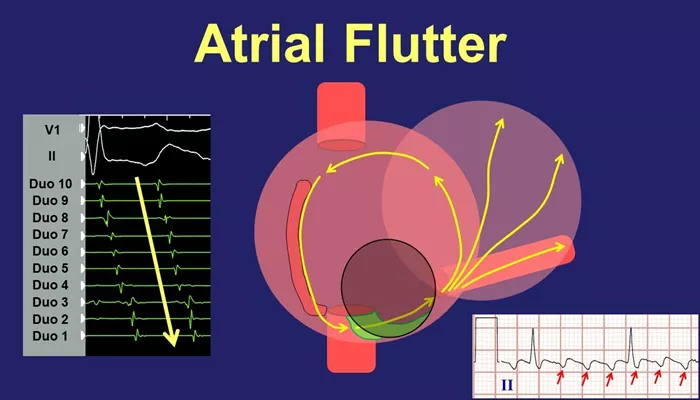Atrial flutter is a type of arrhythmia, a condition where the heart beats irregularly or rapidly. It is characterized by a rapid and organized electrical circuit in the heart’s upper chambers, known as the atria. This condition can lead to various symptoms and complications, making it essential to understand its causes. In this article, we will explore why atrial flutter occurs, detailing the specific reasons behind its development.
What Is Atrial Flutter?
Atrial flutter occurs when the electrical signals in the heart become disorganized, leading to a rapid heartbeat. During this condition, the atria may beat between 250 to 350 times per minute, significantly faster than the normal rate of 60 to 100 beats per minute. This rapid activity can disrupt the heart’s ability to pump blood effectively, increasing the risk of complications such as stroke and heart failure.
Symptoms of Atrial Flutter
Individuals with atrial flutter may experience various symptoms, including:
Palpitations: A sensation of a racing or fluttering heartbeat.
Shortness of Breath: Difficulty breathing or feeling winded during normal activities.
Fatigue: Unusual tiredness or weakness.
Dizziness or Lightheadedness: A feeling of faintness or unsteadiness.
Chest Pain: Discomfort or pain in the chest area.
Fainting: In severe cases, individuals may lose consciousness.
Some people with atrial flutter may not exhibit any symptoms at all, making regular check-ups crucial for early detection.
Causes of Atrial Flutter
Understanding the causes of atrial flutter is essential for prevention and management. The following factors contribute to the development of this arrhythmia:
1. Heart Disease
Heart disease is one of the most significant contributors to atrial flutter. Conditions such as coronary artery disease, heart valve disorders, and previous heart attacks can damage the heart muscle and its electrical system, leading to arrhythmias.
2. Hypertension (High Blood Pressure)
Longstanding hypertension can cause changes in the structure of the heart, particularly in the left atrium. This structural change can predispose individuals to develop atrial flutter as it affects how electrical signals are transmitted through the heart.
see also: Can Deconditioning Cause Tachycardia?
3. Heart Valve Disorders
Conditions affecting the heart valves can disrupt normal blood flow through the heart. Valvular diseases such as mitral valve stenosis or regurgitation can increase pressure in the left atrium and lead to atrial flutter.
4. Congenital Heart Defects
Some individuals are born with structural abnormalities in their hearts that can lead to arrhythmias later in life. These congenital defects can affect how electrical signals travel through the heart.
5. Previous Heart Surgery
Individuals who have undergone open-heart surgery may experience changes in their heart’s electrical pathways due to scarring or damage from surgical procedures. This can increase the likelihood of developing atrial flutter.
6. Chronic Lung Disease
Conditions such as chronic obstructive pulmonary disease (COPD) can lead to low oxygen levels in the blood and increased pressure in the lungs’ blood vessels. This strain on the heart can contribute to arrhythmias like atrial flutter.
7. Hyperthyroidism
An overactive thyroid gland (hyperthyroidism) can increase metabolism and heart rate, leading to arrhythmias. The excess thyroid hormones can disrupt normal electrical conduction in the heart.
8. Alcohol Consumption
Excessive alcohol intake has been linked to an increased risk of developing atrial flutter. Binge drinking or chronic alcohol abuse can lead to “holiday heart syndrome,” where episodes of atrial fibrillation or flutter occur after heavy drinking.
9. Obesity
Obesity is associated with several cardiovascular risks, including hypertension and diabetes, both of which are significant risk factors for atrial flutter. Excess weight can also lead to changes in heart structure and function.
10. Age
The risk of developing atrial flutter increases with age. It is more common in individuals over 50 years old due to age-related changes in heart structure and function.
11. Diabetes
Diabetes mellitus is associated with an increased risk of cardiovascular diseases and arrhythmias due to damage caused by high blood sugar levels over time.
12. Sleep Apnea
Obstructive sleep apnea (OSA) leads to intermittent hypoxia (low oxygen levels) during sleep, which can strain the cardiovascular system and increase the risk of arrhythmias like atrial flutter.
13. Family History
Genetics may play a role in predisposing individuals to atrial flutter and other arrhythmias. A family history of heart disease or arrhythmias may increase one’s risk.
Conclusion
Atrial flutter is a complex condition influenced by various factors ranging from underlying health conditions to lifestyle choices. Understanding these causes is vital for effective prevention and management strategies. Individuals at risk should work closely with healthcare providers to monitor their heart health and address any contributing factors proactively.
Regular medical check-ups, lifestyle modifications such as maintaining a healthy weight, managing blood pressure, controlling diabetes, and avoiding excessive alcohol consumption are essential steps toward reducing the risk of developing atrial flutter.

